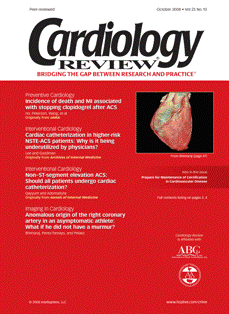Publication
Article
Cardiology Review® Online
Clinical evidence and the practice of medicine
Author(s):
When selecting a treatment strategy in patients with an acute coronary syndrome (ACS), the primary objective is to yield the best long-term clinical outcome. Several risk tools have been developed that are useful in guiding the type and intensity of therapy by identifying the patients most likely to benefit from early invasive versus conservative treatment. One such valuable risk-determination tool is the thrombolysis in myocardial infarction (TIMI) risk score, which was developed based on data from the TIMI IIB and
ESSENCE (Efficacy and Safety of Subcutaneous Enoxaparin in Unstable Angina and
Non-Q-Wave MI) trials. TIMI risk score is determined by the sum of the presence of 7
variables at hospital admission, with 1 point given for each of the following variables: age 65 years or older; at least 3 risk factors for coronary artery disease; prior coronary
stenosis of 50% or more; ST-segment deviation on electrocardiogram; at least 2 anginal events in prior 24 hours; use of aspirin in prior 7 days; and elevated serum cardiac biomarkers. An early invasive strategy (ie, diagnostic angiography with intent to perform revascularization) is indicated in initially stabilized ACS patients (without serious comorbidities or contraindications to such procedures) who are at high risk. Typically, patients with a TIMI risk score of 5 or higher are considered to be at high risk for future adverse events.
Cardiology Review
In this issue of , Lee and Goodman report that higher-risk patients do not get referred for coronary angiography because their risk status is incorrectly assessed. In their analysis, 68% of patients were thought not to be at high enough risk to undergo early invasive therapy, but 59% of these patients were found to be at higher risk when their baseline TIMI risk scores were recalculated. There appears to be an evidence gap; thus, a significant opportunity remains to more appropriately risk stratify patients by using simple Internet- or palm-based tools, such as the TIMI risk score. Patients determined to be at high risk may derive significant benefit from early invasive therapy based on current guidelines. Qayyum and associates report pooled results of the available
clinical trial data for ACS patients who received treatment with either routine invasive
strategy or selective invasive strategy. Their analysis also suggested that the direction of effect seems to favor routine invasive strategy.
The article by Ho and colleagues addresses the dangers of stopping antiplatelet therapy prematurely after ACS. In the first 90 days after stopping clopidogrel (Plavix), ACS patients experienced a nearly two-fold increased risk of death and myocardial infarction.
Clinicians need to educate their patients on the importance of compliance with antiplatelet therapy for the appropriate duration and on other evidence-based therapies, such as statins and beta blockers, after an episode of ACS.
I would like to hear your thoughts on strategies for improving and optimizing the care of ACS patients. Responses can be sent to editor@cardiology-review.com and will be published in an upcoming issue.






